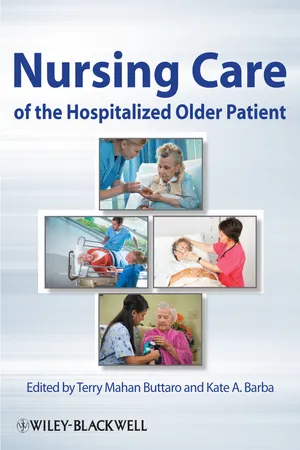
Nursing Care of the Hospitalized Older Patient
- English
- ePUB (mobile friendly)
- Available on iOS & Android
Nursing Care of the Hospitalized Older Patient
About this book
Nursing Care for the Hospitalized Older Patient is a comprehensive, quick-reference resource for registered and advanced practice nurses working with older patients in a hospital setting. Organized in user-friendly format, the book provides vital information on all aspects of hospital care and the full range of health issues encountered by elderly patients. The book is organized into four major sections. The first section provides an overview of the aging patient, including demographics, normal aging changes, and the general impact of hospitalization. The second section covers proper health assessment, providing guidance on history taking and evaluating laboratory values. The third section is the largest part of the book and is made up of short, similarly-structured chapters dedicated to individual clinical issues ranging from burns to depression. These chapters are organized by body system to maximize ease of use. The book concludes with a section on special considerations that cross common clinical areas, such as palliative care, pain management, fall prevention, and discharge planning.
Frequently asked questions
- Essential is ideal for learners and professionals who enjoy exploring a wide range of subjects. Access the Essential Library with 800,000+ trusted titles and best-sellers across business, personal growth, and the humanities. Includes unlimited reading time and Standard Read Aloud voice.
- Complete: Perfect for advanced learners and researchers needing full, unrestricted access. Unlock 1.4M+ books across hundreds of subjects, including academic and specialized titles. The Complete Plan also includes advanced features like Premium Read Aloud and Research Assistant.
Please note we cannot support devices running on iOS 13 and Android 7 or earlier. Learn more about using the app.
Information
Chapter 1
Introduction
Demographics
Theories of aging
Healthy aging
- Ideal weight for height
- Normal blood pressure, blood sugar, and cholesterol
- Daily exercise
- 10,000 steps per day or 30 minutes a day
- Weight training twice weekly to strengthen abdomen, back, chest, arms, shoulders, hip and leg muscles
- Balance training each day
- Low fat, low cholesterol, low calorie diet, that includes:
- lean meats
- fruits, fiber, and vegetables
- adequate calcium and vitamin D
- 1 glass red wine per day
- Fewer medications
- Smoking cessation
- Stress reduction
- Breathing exercises
- Meditation
- Yoga
- Socialization
Normal aging changes
- Decreased body water
- Increased body weight
- Homeostasis easily affected by illness
- Temperature regulation impacted over time
- Gait changes especially after age 80 may be multifactorial
- Increased double stance time; decreased gait speed
- Cellular changes
- Diminished cell mediated immunity
- Decreased number of receptors and diminished receptor sensitivity impact medication pharmacodynamics
- Skin: initial aging changes are seen in skin changes
- Epidermis thins, becomes dryer and less elastic
- Decreased subcutaneous fat
- Sweat glands, blood vessels, melanocytes, and nerve cells decrease in number
- Absorption of topical medications is more rapid
- Head, ears, eyes, nose, throat (HEENT)
- Visual and hearing changes
- Decreased thirst
- Diminished sense of smell and taste
- Cardiac
- Cardiac and arterial muscle stiffening results in some cardiac enlargement, hypertension
- Decreased baroreceptor sensitivity
- Decreased cardiac output affects blood flow to all organs and can affect medication absorption, distribution, first pass effect, biotransformation, and elimination
- Respiratory
- Possible increase in AP chest diameter
- Decreased bronchiolar smooth muscle
- Vital capacity decreases, residual volume increases
- Increased risk aspiration
- Gastrointestinal
- Atrophic gastritis
- Decreased absorption medication/nutrients is possible.
- Diminished esophageal motility
- Functional changes in swallowing (usually related to medications or neurological disorder)
- Decreased hepatic blood flow
- Genitourinary
- Decreased blood flow can cause decreased glomerular filtration and tubular secretion; diminished creatinine clearance.
- Decreased number of nephrons
- Diminished bladder capacity
- Prostate enlargement
- Incontinence
- Musculoskeletal
- Decreased muscle mass and strength
- Increased bone loss
- Neurological
- Brain atrophy
- Increased fragility of blood vessels
- Neurodegenerative changes include decreased nerve impulse conduction
- Decreased cerebral blood flow
- Decreased proprioception (spacial awareness).
Impact of hospitalization on older adults
Table of contents
- Cover
- Title page
- Copyright page
- Dedication
- Contributors
- Preface
- Acknowledgments
- Chapter 1: Introduction
- Chapter 2: Health Assessment
- Chapter 3: Clinical Issues
- Chapter 4: Special Considerations
- Glossary
- Selected Websites for Geriatric Information
- Index